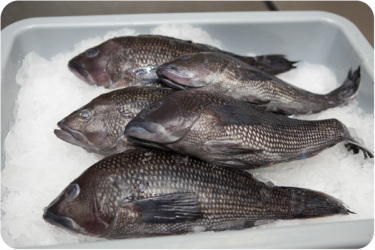Black Sea Bass (Centropristis striata)
Our fresh, local black sea bass is firm yet tender, and has a mild, fresh, delicate flavor. Black sea bass is a great choice if you're trying to eat healthy: It's a good source of naturally low-fat protein and magnesium. Recommended cooking methods are sautéing and baking, pairing well with a basic mix of butter, salt, and pepper.
Our black sea bass is both simple and versatile, and pairs very well with mushrooms, tomatoes, and vinegar (especially sherry vinegar).
Other good complementary flavors are: bacon, bay leaf, chervil, cilantro, coriander, fennel, fresh garlic, lemon, lime, marjoram, mint, parsley, sesame seeds, soy sauce, spinach, thyme, vermouth, and dry white wine.
It is served well with: red and green bell peppers, carrots, leeks/onions/shallots, potatoes, and shrimp.
Some great chef-approved combinations:
- black sea bass + bacon + corn + fava beans
- black sea bass + mushrooms + sesame seeds
Click here for our Black Sea Bass Recipes.
Biology: Black sea bass are found from inshore to 425 feet of depth, from Maine to the Gulf of Mexico. They spend most of their time close to the seafloor, and congregate around rocks and piers. Black sea bass eat anything that is available, but their favorite foods are crabs, worms, and clams. They are in turn preyed upon by skate, dogfish, fluke, and monkfish. They migrate inshore in spring. Most black sea bass begin their lives as females, and turn into males between their second and fifth years of life. Some males become dominant, and others become subordinate; these differences are apparent in their shape and markings.
Sustainability status: Recent stock assessments indicate that the New England black sea bass stock is not experiencing overfishing and that the stock is rebuilt. More information is available here.
Harvest: We catch our black sea bass in pots (traps). Since they are drawn to shelter, it is not necessary to bait the pots. Black sea bass can also be caught by floating fish traps, bottom trawls, and rod and reel.
Nutritional facts: Black sea bass are a good source of protein and magnesium. A 100-gram portion of black sea bass contains 18.43 grams of protein, 36.5 grams selenuim, 97 calories, 2 grams of fat, 41 mg cholesterol, and 68 mg sodium.
Available whole or filleted, from June through August.
Return to species guide to continue browsing species.

